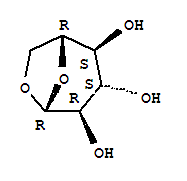| Identification |
| Name: | b-D-Glucopyranose, 1,6-anhydro- |
| Synonyms: | D-Glucose,1,6-anhydro- (6CI);Levoglucosan (8CI);1,6-Anhydro-D-glucopyranoside;1,6-Anhydro-D-glucose;1,6-Anhydro-b-D-glucopyranose;1,6-Anhydro-b-D-glucose;1,6-Anhydroglucose;Leucoglucosan;NSC 46243; |
| CAS: | 498-07-7 |
| EINECS: | 207-855-0 |
| Molecular Formula: | C6H10O5 |
| Molecular Weight: | 162.14 |
| InChI: | InChI=1/C6H10O5/c7-3-2-1-10-6(11-2)5(9)4(3)8/h2-9H,1H2 |
| Molecular Structure: |
 |
| Properties |
| Flash Point: | 185.9°C |
| Boiling Point: | 383.8°C at 760 mmHg |
| Density: | 1.688g/cm3 |
| Refractive index: | -66.5 ° (C=2, H2O) |
| Alpha: | -66 º (C=1 IN H2O) |
| Specification: |
White Crystalline Odourless Solid
usageEng:1,6-Anhydrohexopyranoses have proven to be valuable synthons for the preparation of biologically important and structurally diverse products (e.g. rifamycin S, indanomycin, thromboxane B2, (+)-biotin, tetrodotoxin, quinone, and macrolide antibiotics) as
Safety Statements:22-24/25-36-26
22:Do not breathe dust
24/25:Avoid contact with skin and eyes
36:Wear suitable protective clothing
26:In case of contact with eyes, rinse immediately with plenty
of water and seek medical advice |
| HS Code: | 29400000 |
| Flash Point: | 185.9°C |
| Storage Temperature: | 2-8°C |
| Usage: | 1,6-Anhydrohexopyranoses have proven to be valuable synthons for the preparation of biologically important and structurally diverse products (e.g. rifamycin S, indanomycin, thromboxane B2, (+)-biotin, tetrodotoxin, quinone, and macrolide antibiotics) as |
| Safety Data |
| |
 |